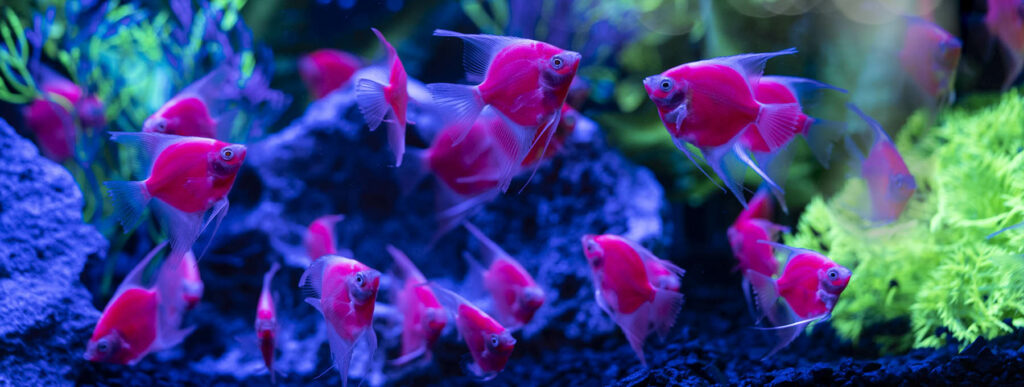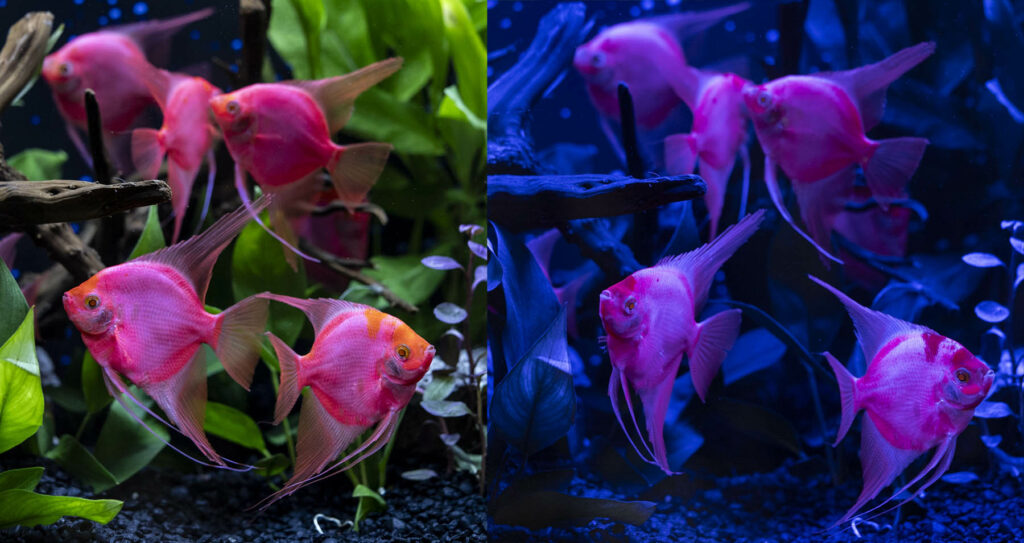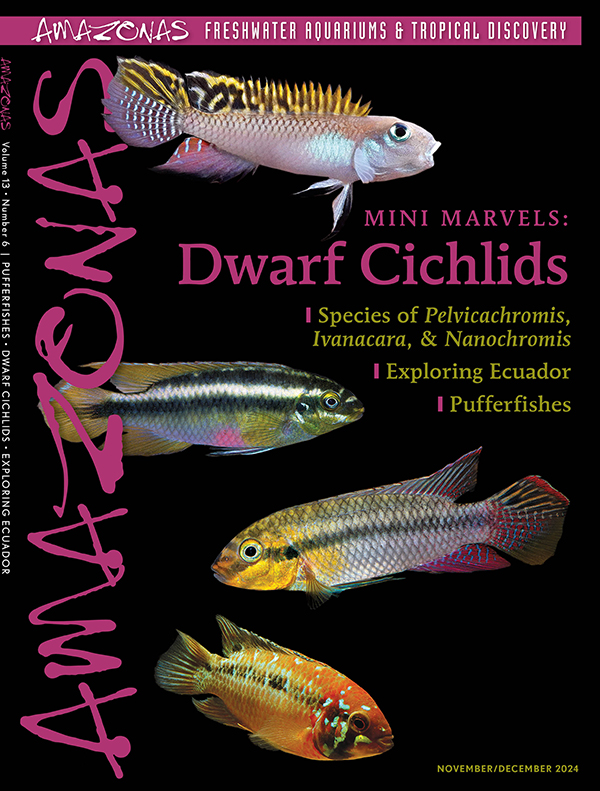
Excerpt from AMAZONAS Magazine Vol 13.6, November/December 2024
By Alex Rose
Cue the outrage and strike up the backlash, because here comes another GloFish®! The new Starfire Red® Angelfish was released this summer and is officially available at local fish and pet stores as well as Petco, Pet Supplies Plus, and Meijer. This is the seventh species offered in a suite of fluorescent fish options that includes two species of tetras, Tiger Barbs, Rainbow Sharks, Bettas, a Corydoras catfish, and now Angelfish.
In the words of Spectrum Brands from a mid-summer press release, “GloFish Angelfish will be available in Starfire Red, a captivating and colorful addition to the aquarium. While they’re identical in behavior and care requirements to their wild-type counterparts, GloFish Angelfish produce a fluorescent protein that stands out spectacularly under blue LED lights. Ambient sunlight and white LED aquarium lighting also highlight their vivid color.”
I saw these fluorescent angels in person for the first time at Global Pet Expo in Orlando earlier this year, and while I still have no plans to keep GloFish in my own tanks, I thought they were objectively the nicest-looking fish from the GloFamily that have been created so far. This is of course just my opinion, but I’ve heard similar ones echoed by other aquarists whose perspectives I value. Anecdotally, shop managers say they’re having a hard time keeping up with demand, so it appears customers are seeing something they like. Dave Drake, Sales Manager at 5D Tropical, told me “The first true barometer for the success of this fish was Aquashella in Dallas, and the public went nuts. We had two tanks set up—one with natural decor and live plants, the other with GloFish aquarium accessories—and almost all the interactions were positive. Kids and adults were equally enthusiastic, and I think this has been the most successful launch of a single GloFish species yet.”

While the GloFish-branded angelfish is new, glowing angelfish have been seen before. At a 2012 aquarium expo in Taipei, bubblegum pink, fluorescent angelfish were displayed as the result of a joint project between Taiwan’s Academia Sinica, National Taiwan Ocean University, National Kaohsiung Marine University, and JY Lin Trading, a private biotechnology company. The group also debuted identically colored Archocentrus nigrofasciatus (Convict Cichlid) at the same expo.

After doing a bit of digging, I found out that a professor at National Kaohsiung Marine University had discovered a fluorescent protein in an Acropora coral in Taiwan’s waters, which was then used by a different professor at National Taiwan Ocean University to “micro-transfuse” this protein into angelfish eggs. After three years of research, they were still only able to successfully transfuse the coral protein into about one percent of the eggs, and that was up from 0.01 percent when the efforts began. These numbers aren’t viable for a commercial operation, and there are rumors that these fish “didn’t breed true”.
The Red Fluorescent Protein (GloRFP) that gives GloFish the Starfire Red coloration comes from an anemone. Transgenic fish are most commonly created by microinjecting mRNA that encodes the protein of interest into one- to four-cell embryos, so I would predict that this is the same general method used for GloFish Angelfish. Broodstock then pass this genetic modification on to their offspring, establishing a line of glowing fish that are patented and cannot be legally reproduced. Like them or not, these fishes are part of the hobby, and the brand will likely continue expanding.
Editor’s Note: See some additional images of the GloFish®! Starfire Red® Angelfish in the forthcoming November/December 2024 issue of AMAZONAS Magazine. Subscribe today and never miss an issue!






The Island Of Dr Moreau comes to mind… Its creepy.. What’s next, Electric Blue Dalmatians ?
Florescent angelfish! I just be doggone!
I don’t like the idea of GMO fish, nature is beautiful already. It’s not natural.
This is not in the interest of real animal keeping. People Who buy these horrible creatures are not real animal lovers. They only want something kreepy
The article you linked to, and what these fish are, are two VERY DIFFERENT things. The “painted glassfish” and other examples that make up the bulk of that article are dyed & laser tattooed, indeed a cruelty that our publication has denounced, as have MOST in the aquarium hobby and industry. The fluorescent fish shown here are genetically modified to include a gene for fluorescent protein production that originated from a sea anemone. A very different thing in every sense. We’ve covered these topics in great depth in our Man-Made Fishes issue; https://www.aquaticmediapress.com/shop/amazonas-magazine-back-issues/amazonas-sep-oct-2019-man-made-fishes/. It’s available as a printed back issue, and is included in the digital archive, part of every active AMAZONAS subscription. Curious for your thoughts after you’ve had a chance to read that issue!
Ther are plenty of beautiful, naturally coloured fish already. Besides, injecting fish with dyes is an abomination
OK, I didn’t see the bit about genetic modification. Still, why do we need it?
I think these people that are creating these glow fish are ruining the hobby for us that want to keep the hobby without these glow fish and breed fish true to the way they are in the wild.
I wonder how many people who decry GloFish, yet are just fine with Parrot Cichlids, and others with purpose bred abnormal body types like Balloon Rams ? It is after all a business, one that is driven by profit. Hobbyists need to remember that very few tropical fish would be available without these profit driven enterprises. If you don’t like something, don’t buy it. Voting with your dollars if far more effective than anything else you can do. As it stands now. There are fewer and fewer independent tropical fish stores available to support the hobby. Frankly anything they can do to make a few more sales, and attract new customers is fine with me. Even by selling these modified fish I would have no interest in owning. Complaining about these new, and questionable breeding methods will only detract from promoting the growth of this industry. Like it or not. If it sells, someone will provide these to interested buyers. That’s just how this whole system works…
I’m glad to see that it is genetic modification vs injecting them or dye.